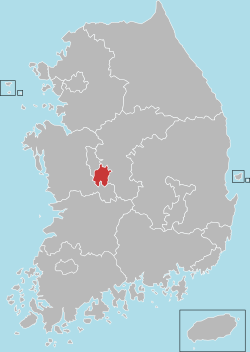
Back Daejeon ACE Daejeon Afrikaans دايجون Arabic Tecon Azerbaijani Тэджон Bashkir Daejeon BAN Тэджон Byelorussian Теджън Bulgarian Daejeon Bislama দেজন Bengali/Bangla
Daejeon
대전 | |
|---|---|
| Daejeon Metropolitan City 대전광역시 | |
| transcription(s) | |
| • Hangul | 대전광역시 |
| • Hanja | 大田廣域市 |
| • Revised Romanization | Daejeon-gwangyeoksi |
| • McCune-Reischauer | Taejŏn-kwangyŏksi |
Clockwise from top: view of Daejeon from Bomunsan Mountain; Daejeoncheon; Government Complex Daejeon; Uam Historic Park; and Daejeon Station | |
 | |
 | |
| Coordinates: 36°21′00″N 127°23′06″E / 36.350°N 127.385°E | |
| Country | South Korea |
| Region | Hoseo |
| Districts | 5 |
| Government | |
| • Type | Mayor–council |
| • Mayor | Lee Jang-woo (People Power) |
| • Body | Daejeon Metropolitan Council |
| Area | |
| • Total | 539.85 km2 (208.44 sq mi) |
| Population (January 2022) | |
| • Total | 1,469,543 |
| • Density | 2,700/km2 (7,100/sq mi) |
| • Dialect | Chungcheong |
| GDP | |
| • Total | KR₩ 50 trillion US$ 40 billion (2022) |
| ISO 3166 code | KR-30 |
| Flower | White magnolia |
| Tree | Pine |
| Bird | Korean magpie |
| Website | daejeon.go.kr |
Daejeon (Korean: [tɛdzʌn] ) is South Korea's fifth-largest metropolis, with a population of 1.5 million as of 2019.[2] Located in a central lowland valley alongside forested hills and the Geum River, the city is known for its technology and research institutions, and for celebrating its natural environment, with most mountains, hot springs, and rivers freely open for public use.[3][4] Daejeon serves as a hub of transportation for major rail and road routes, and is approximately 50 minutes from the capital, Seoul, by KTX or SRT high speed rail.[5]
Daejeon (along with Seoul, Gwacheon and Sejong City) is one of South Korea's administration hubs. The city is home to 23 universities and colleges, including Korea Advanced Institute of Science and Technology (KAIST) and Chungnam National University, as well as government research institutes, and research and development centers for many chaebols such as Samsung, LG, mostly located in the city's Daedeok Science Town.[6][7]
Occupied by humans since the Stone Age, Daejeon was historically a collection of small riverside villages.[8] Though the area had varying degrees of strategic importance depending on the period in history, it was largely undeveloped until its use as a rail hub from the early 1900s, during the period of Japanese occupation.[9] From the 1980s, multiple national administrative functions were moved from Seoul to Daejeon, most of which are now located in the Daejeon Government Complex, resulting in another population increase.[10] The city was a sub host for the 1986 Asian Games,hosted the Expo 1993, the International Mathematical Olympiads in 2000 and will be the 2027 FISU Summer World University Games main host city, and was elevated to the status of Metropolitan City in 2005.[11][12]
Daejeon is situated in a lowland valley with three major rivers, all of them eventually flowing into the Yellow Sea by way of the Geum river. The city is surrounded by several small mountains, and is located approximately 170 km (105.6 mi) south of Seoul and 290 km (180 mi) north of Busan, and 70 km (43 mi) east of the Yellow Sea.[13] Daejeon experiences a monsoon-influenced, four-season climate with wet, hot summers and drier, cold winters.[citation needed]
- ^ "2022년 지역소득(잠정)". www.kostat.go.kr.
- ^ "Timelines Explorer – Data Commons". datacommons.org. Archived from the original on 16 November 2021. Retrieved 18 November 2021.
- ^ "12 Attractions of Daejeon". Daejeon Metropolitan City Culture and Tourism. Archived from the original on 8 May 2018. Retrieved 18 November 2021.
- ^ Cite error: The named reference
:0was invoked but never defined (see the help page). - ^ "KTX Train Schedule | From Seoul to Daejeon". KTX TRAINS. Archived from the original on 20 April 2021. Retrieved 26 March 2021.
- ^ "Welcome to Daejeon Metropolitan City". 18 November 2006. Archived from the original on 18 November 2006. Retrieved 3 October 2022.
- ^ Kang, Byung Sam (2021). The Road to Korea – Science & Technology Park. Korea Innovation Foundation. pp. 31, 60, 67. ISBN 979-11-976808-1-6.
- ^ "Daejeon Metropolitan City: About Daejeon". Archived from the original on 9 July 2015. Retrieved 7 August 2015.
- ^ "근대의대전". Archived from the original on 3 October 2022. Retrieved 3 October 2022.
- ^ "Government Buildings Management Office". gbmo.go.kr (in Korean). Archived from the original on 26 June 2022. Retrieved 3 October 2022.
- ^ Song-Du-Bum (July 2000). "Scientific-industrial and nucleus administrative city, Daejeon". GukTo(country). 7 (225): 70. Archived from the original on 3 December 2013. Retrieved 7 April 2013.
- ^ "현대의대전". Archived from the original on 3 October 2022. Retrieved 3 October 2022.
- ^ "위치 | 대전광역시청". 11 July 2022. Archived from the original on 11 July 2022. Retrieved 3 October 2022.
{{cite web}}: CS1 maint: bot: original URL status unknown (link)
© MMXXIII Rich X Search. We shall prevail. All rights reserved. Rich X Search







